第2章 Spring中的Bean
2.1 Bean的配置
Bean本质是Java中的类。Spring可以被看做一个大型工厂,这个工厂的作用就是生产和管理Spring容器zho中的Bean。想在项目中使用这个工厂,就需要对Spring的配置文件进行配置。
Spring支持XML和Properties两种格式的配置文件。常用XML文件配置,该方式通过XML文件来注册并管理Bean之间的依赖关系。
XML配置文件的根元素是<beans>,包含了多个<bean>子元素,每个子元素地定义一个Bean。
<bean>元素的常用属性及其子元素
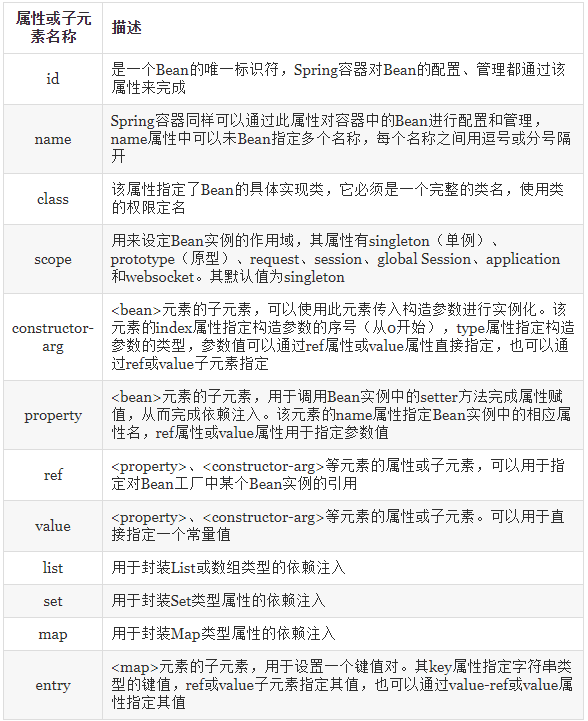
如果在Bean中未指定id和name,则Spring会把class的值当做id使用。
getBean( id/name/class );
2.2 Bean的实例化:
2.21 构造器实例化:Spring容器通过Bean对应类中默认的无参构造方法来实例化Bean
package com.itheima.instance.constructor;
public class Bean1 {
<?xml version="1.0" encoding="UTF-8"?>
<beans xmlns="http://www.springframework.org/schema/beans"
xmlns:xsi="http://www.w3.org/2001/XMLSchema-instance"
xsi:schemaLocation="http://www.springframework.org/schema/beans
http://www.springframework.org/schema/beans/spring-beans-4.3.xsd">
<bean id="bean1" class="com.itheima.instance.constructor.Bean1" />
</beans package com.itheima.instance.constructor;
package com.itheima.instance.constructor;
import org.springframework.context.ApplicationContext;
import
org.springframework.context.support.ClassPathXmlApplicationContext;
public class InstanceTest1 {
public static void main(String[] args) {
// 定义配置文件路径
String xmlPath = "com/itheima/instance/constructor/beans1.xml";
// ApplicationContext在加载配置文件时,对Bean进行实例化
ApplicationContext applicationContext = new ClassPathXmlApplicationContext(xmlPath);
Bean1 bean = (Bean1) applicationContext.getBean("bean1");
System.out.println(bean);
}
}
如果xml文件不在包里,就不需要在路径上加入包名;如果在包里,需要加上包名。
输出类Bean1的地址:
com.itheima.instance.constructor.Bean1@234bef66
2.22静态工厂方式实例化:要求开发者创建一个静态工厂的方法来创建Bean的实例,其Bean配置中的class属性所指定的不再是Bean实例的实现类,而是静态工厂类,同时还需要使用factory-method属性来指定所创建的静态工厂方法。
package com.itheima.instance.static_factory;
public class Bean2 {
}
package com.itheima.instance.static_factory;
public class MyBean2Factory {
//使用自己的工厂创建Bean2实例
public static Bean2 createBean222(){
return new Bean2();
}
}
<?xml version="1.0" encoding="UTF-8"?>
<beans xmlns="http://www.springframework.org/schema/beans"
xmlns:xsi="http://www.w3.org/2001/XMLSchema-instance"
xsi:schemaLocation="http://www.springframework.org/schema/beans
http://www.springframework.org/schema/beans/spring-beans-4.3.xsd">
<bean id="bean2" class="com.itheima.instance.static_factory.MyBean2Factory"
factory-method="createBean222" />
<!-- factory-method后面等于的东西是方法 -->
</beans>
package com.itheima.instance.static_factory;
public class MyBean2Factory {
//使用自己的工厂创建Bean2实例
public static Bean2 createBean222(){
return new Bean2();
}
}
输出类Bean2的地址:
com.itheima.instance.static_factory.Bean2@7921b0a2
说白了就是,有一个类叫Bean2,要实例化Bean2,这种方法不直接实例化它,要再创一个工厂类MyBean2Factory,工厂类里有个方法返回实例化的Bean2,return new Bean2(),先new再返回,并且这个方法名和Factory-method对应。
2.23实例工厂方法实例化:采用实例工厂,不再是静态工厂,采用直接创建Bean实例的方式。
package com.itheima.instance.factory;
public class Bean3 {
}
package com.itheima.instance.factory;
public class MyBean3Factory {
public MyBean3Factory() {
System.out.println("bean3工厂实例化中");
}
//创建Bean3实例的方法
public Bean3 createBean111(){
return new Bean3();
}
}
<?xml version="1.0" encoding="UTF-8"?>
<beans xmlns="http://www.springframework.org/schema/beans"
xmlns:xsi="http://www.w3.org/2001/XMLSchema-instance"
xsi:schemaLocation="http://www.springframework.org/schema/beans
http://www.springframework.org/schema/beans/spring-beans-4.3.xsd">
<!-- 配置工厂 -->
<bean id="myBean3Factory"
class="com.itheima.instance.factory.MyBean3Factory" />
<!-- 使用factory-bean属性指向配置的实例工厂,
使用factory-method属性确定使用工厂中的哪个方法-->
<bean id="bean3" factory-bean="myBean3Factory"
factory-method="createBean111" />
</beans>
package com.itheima.instance.factory;
import org.springframework.context.ApplicationContext;
import
org.springframework.context.support.ClassPathXmlApplicationContext;
public class InstanceTest3 {
public static void main(String[] args) {
// 指定配置文件路径
String xmlPath = "com/itheima/instance/factory/beans3.xml";
// ApplicationContext在加载配置文件时,对Bean进行实例化
ApplicationContext applicationContext =
new ClassPathXmlApplicationContext(xmlPath);
System.out.println(applicationContext.getBean("bean3")); //顺便尝试构造器实例化
String xmlPath2 = "com/itheima/instance/factory/beans3.xml";
ApplicationContext applicationContext2 =
new ClassPathXmlApplicationContext(xmlPath2);
System.out.println(applicationContext2.getBean("myBean3Factory"));
}
}
输出:
bean3工厂实例化中
com.itheima.instance.factory.Bean3@7921b0a2
bean3工厂实例化中
com.itheima.instance.factory.MyBean3Factory@32d992b2
这种方式说白了就是:有一个类Bean3,要实例化它,不直接实例化,再造一个工厂类MyBean3Factory来return new Bean3();
在xml文件中,先配置实例工厂类的bean;再配置要类Bean3的bean,并通过factory-bean指明是哪个实例工厂类(谁)要实例它,再通过factory-method指明是哪个方法来返回实例后的它。
(回顾旧知识:实例工厂类MyBean3Factory里面有一个无参构造函数,在实例MyBean3Factory的时候自动执行该方法,构造函数要求是无参无返回值,方法名和类名一样)
2.3 Bean的作用域
Spring 4.3中为Bean的实例定义了7种作用域。
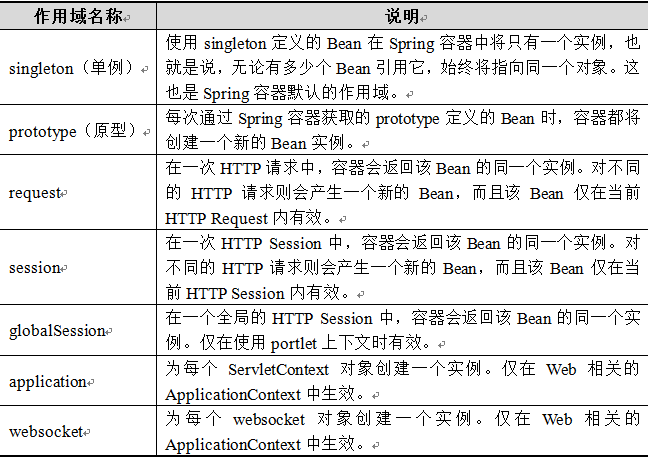
singleton和prototype最常用,解释如下。
1.singleton作用域:
Spring容器默认的作用域,当Bean作用域为singleton时,Spring容器就会存在一个共享的Bean实例,并且所有对Bean的请求,只要id与该Bean的id属性相匹配,就会返回同一个Bean实例。singleton作用域对于无会话状态的Bean(如Dao组件、Service组件)来说,是最理想的选择。演示如下:
package com.itheima.scope;
public class Scope {
}
<?xml version="1.0" encoding="UTF-8"?>
<beans xmlns="http://www.springframework.org/schema/beans"
xmlns:xsi="http://www.w3.org/2001/XMLSchema-instance"
xsi:schemaLocation="http://www.springframework.org/schema/beans
http://www.springframework.org/schema/beans/spring-beans.xsd"> <bean id="scope" class="com.itheima.scope.Scope" scope="singleton"/>
</beans>
package com.itheima.scope;
import org.springframework.context.ApplicationContext;
import
org.springframework.context.support.ClassPathXmlApplicationContext;
public class ScopeTest {
public static void main(String[] args) {
// 定义配置文件路径
String xmlPath = "com/itheima/scope/beans4.xml";
// 加载配置文件
ApplicationContext applicationContext =
new ClassPathXmlApplicationContext(xmlPath);
// 输出获得实例
System.out.println(applicationContext.getBean("scope"));
System.out.println(applicationContext.getBean("scope"));
}
}
输出:
com.itheima.scope.Scope@234bef66
com.itheima.scope.Scope@234bef66
2.prototype作用域:
对需要保持会话状态的Bean(如Struts2的Action类)应该使用prototype作用域。在使用prototype作用域时,Spring容器会为每个对该Bean的请求都创建一个新的实例。
xml文件中的<bean>改一下,<bean id="scope" class="com.itheima.scope.Scope" scope="prototype" />
输出:
com.itheima.scope.Scope@5a61f5df
com.itheima.scope.Scope@3551a94
2.4 Bean的生命周期
例如singleton和prototype作用域的生命周期。
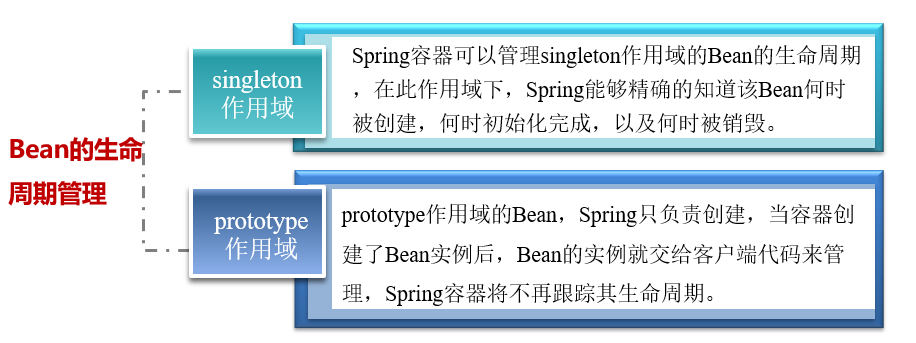
singleton关闭时销毁,prototype长时间不用自动销毁。
Bean生命周期流程图:
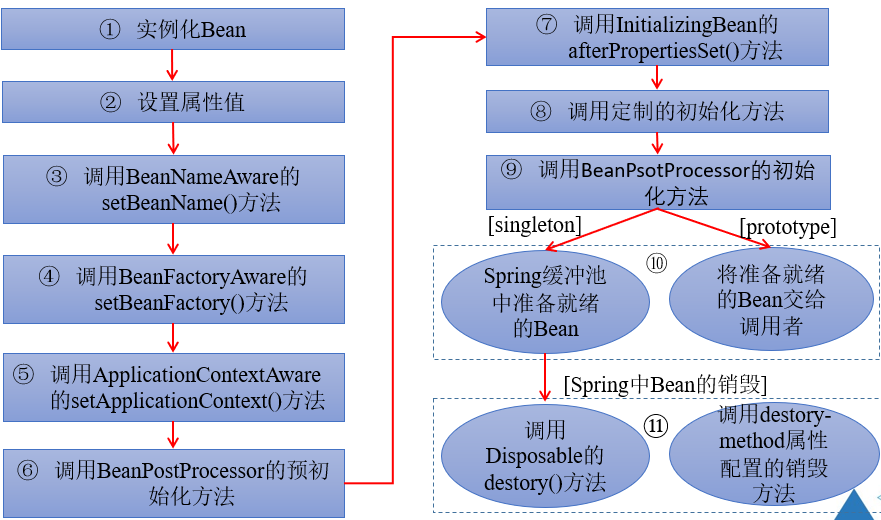
2.5 Bean的装配方式:
Bean的装配可以理解为依赖关系注入,Bean的装配方式即Bean依赖注入的方式。Spring容器支持多种形式的Bean的装配方式,如基于XML的装配、基于注解(Annotation)的装配和自动装配(其中最常用的是基于注解的装配)。
2.51 基于XML的装配:设值注入(Setter Injectiion)和构造注入(Constructor Injection)
构造注入要求:提供默认无参构造方法,为所有属性提供setter方法
设值注入要求:Bean类必须提供一个默认的无参构造方法,并且为需要注入的属性提供对应的setter方法
package com.itheima.assemble;
import java.util.List;
public class User {
private String username;
private Integer password;
private List<String> list;
/**
* 1.使用构造注入
* 1.1提供带所有参数的有参构造方法。
*/
public User(String username, Integer password, List<String> list) {
super();// 调用父类的无参构造方法,可以不写
this.username = username;
this.password = password;
this.list = list;
}
/**
* 2.使用设值注入
* 2.1提供默认空参构造方法 ;
* 2.2为所有属性提供setter方法。
*/
public User() {//无参构造方法
super();//// 调用父类Object的无参构造方法,可以不写
}
public void setUsername(String username) {
this.username = username;
}
public void setPassword(Integer password) {
this.password = password;
}
public void setList(List<String> list) {
this.list = list;
}
@Override
public String toString() { // 重写父类的Object的toString方法
return "User [username=" + username + ", password=" + password +
", list=" + list + "]";
}
}
<?xml version="1.0" encoding="UTF-8"?>
<beans xmlns="http://www.springframework.org/schema/beans"
xmlns:xsi="http://www.w3.org/2001/XMLSchema-instance"
xsi:schemaLocation="http://www.springframework.org/schema/beans
http://www.springframework.org/schema/beans/spring-beans-4.3.xsd">
<!--1.使用构造注入方式装配User实例 -->
<bean id="user1" class="com.itheima.assemble.User">
<constructor-arg index="0" value="tom" />
<constructor-arg index="1" value="123456" />
<constructor-arg index="2">
<list>
<value>"constructorvalue1"</value>
<value>"constructorvalue2"</value>
</list>
</constructor-arg>
</bean>
<!--2.使用设值注入方式装配User实例 -->
<bean id="user2" class="com.itheima.assemble.User">
<property name="username" value="张三"></property>
<property name="password" value="654321"></property>
<!-- 注入list集合 -->
<property name="list">
<list>
<value>"setlistvalue1"</value>
<value>"setlistvalue2"</value>
</list>
</property>
</bean>
</beans>
构造注入:constructor-arg元素中的index表示的是有参构造方法的参数顺序,value表示注入的值。
设值注入:property元素中的name表示要注入的属性名,value表示要注入的值,子元素list同样表示要注入的值。
package com.itheima.assemble;
import org.springframework.context.ApplicationContext;
import
org.springframework.context.support.ClassPathXmlApplicationContext;
public class XmlBeanAssembleTest {
public static void main(String[] args) {
// 定义配置文件路径
String xmlPath = "com/itheima/assemble/beans5.xml";
// 加载配置文件
ApplicationContext applicationContext = new ClassPathXmlApplicationContext(xmlPath);
// 构造方式输出结果
System.out.println(applicationContext.getBean("user1"));
// 设值方式输出结果
System.out.println(applicationContext.getBean("user2"));
}
}
为了能看到结果,重写toString方法。
输出:
User [username=tom, password=123456, list=["constructorvalue1", "constructorvalue2"]]
User [username=张三, password=654321, list=["setlistvalue1", "setlistvalue2"]]
2.52 基于注解(Annotation)的装配
XML文件可以实现Bean的装配工作,但是Bean多时,XML文件臃肿巨大,为后续的维护和升级带来困难。为此,提供了对注解技术的全面支持。
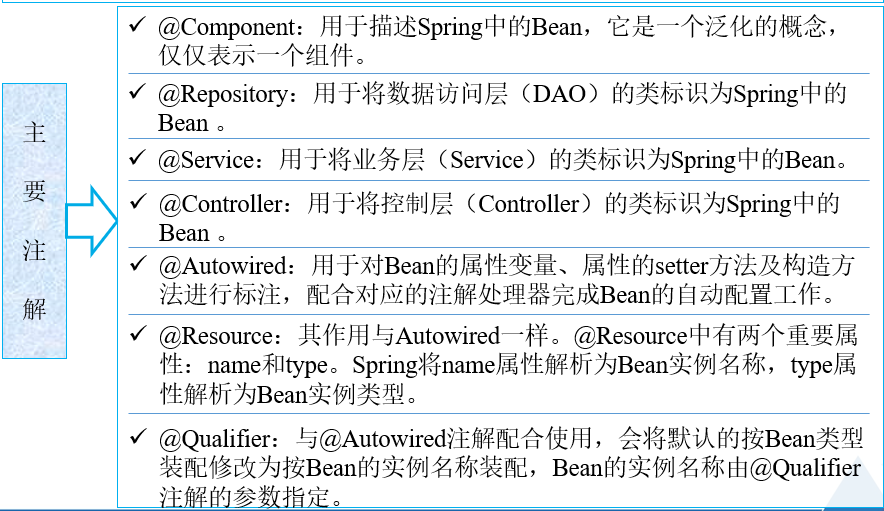
package com.itheima.annotation;
public interface UserDao {
public void save();
}
package com.itheima.annotation;
import org.springframework.stereotype.Repository; /**首先使用@Repository注解将UserDaoImpl类标识为Spring中的Bean,相当于配置文件中的
<bean id="userDao" class="com.itheima.annotation.UserDaoImpl"/> 很普通的配置
*/
@Repository("userDao")
public class UserDaoImpl implements UserDao{
public void save(){
System.out.println("userdao...save...");
}
}
package com.itheima.annotation;
public interface UserService {
public void save();
}
package com.itheima.annotation;
import javax.annotation.Resource;
import org.springframework.stereotype.Service; /**使用@Service注解将UserServiceImpl类标识为Spring中的Bean,相当于
<bean id="userService" class="com.itheima.annotation.UserServiceImpl"/> 很普通的配置*/
@Service("userService") public class UserServiceImpl implements UserService{ /**使用@Resource注解标注属性uesrDao上,相当于配置文件中的
<property name="userDao" ref="userDao"/>,
不是普通的配置,依赖注入,将id为userDao的Bean实例注入到userService实例中
*/
@Resource(name="userDao")
private UserDao userDao;
public void save() {
//调用userDao中的save方法
this.userDao.save();
System.out.println("userservice....save...");
}
public void setUserDao(UserDao userDao) {
this.userDao = userDao;
}
}
package com.itheima.annotation;
import javax.annotation.Resource;
import org.springframework.stereotype.Controller; /**使用@Controller 注解标注了 UserController类,这相当于配置文件中编写
<bean id="userController" class="com.itheima.annotation.UserController"/>;普通配置
*/
@Controller("userController") public class UserController {
/**
@Resource 注解标注在userService属性上,相当于配置文件中编写
<property name="userService" ref="userService"/>,依赖注入
*/
@Resource(name="userService")
private UserService userService;
public void save(){
this.userService.save();
System.out.println("userController...save...");
}
public void setUserService(UserService userService) {
this.userService = userService;
}
}
<?xml version="1.0" encoding="UTF-8"?>
<beans xmlns="http://www.springframework.org/schema/beans"
xmlns:xsi="http://www.w3.org/2001/XMLSchema-instance"
xmlns:context="http://www.springframework.org/schema/context"
xsi:schemaLocation="http://www.springframework.org/schema/beans
http://www.springframework.org/schema/beans/spring-beans-4.3.xsd
http://www.springframework.org/schema/context
http://www.springframework.org/schema/context/spring-context-4.3.xsd"> <!-- 凡出现context都是约束信息,使用 context 命名空间 ,在配置文件中开启相应的注解处理器 -->
<context:annotation-config />
<!--使用 context 命名空间 ,通知Spring扫描指定包下所有Bean类,进行注解解析-->
<context:component-scan base-package="com.itheima.annotation" />
</beans>
package com.itheima.annotation;
import org.springframework.context.ApplicationContext;
import
org.springframework.context.support.ClassPathXmlApplicationContext;
public class AnnotationAssembleTest {
public static void main(String[] args) {
// 定义配置文件路径
String xmlPath = "com/itheima/annotation/beans6.xml";
// 加载配置文件
ApplicationContext applicationContext =
new ClassPathXmlApplicationContext(xmlPath);
// 获取UserController实例
UserController userController =
(UserController) applicationContext.getBean("userController");
// 调用UserController中的save()方法
userController.save();
}
}
输出:
userdao...save...
userservice....save...
userController...save...
说白了,先配置类Dao,再把Dao用依赖注入的方式注入到Service,再把Service用依赖注入的方式注入到Controller。注解的配置和注入形式不一样,最后在控制层调用say方法,层层往下,先到服务层,再到数据层,数据层(Dao层)是底层,再层层往上分别调用say方法,因此输出顺序是Dao,Service,Controller。
(上述案例中用@Autowired注解替换@Resource也可以达到同样效果)
2.53 自动装配
注解方式装配一定程度减少配置文件的代码量,但是也有企业项目是没有使用注解方式开发的,自动装配也可以减少代码量。
Bean元素中包含一个autowire属性,通过属性值来自动装配Bean元素。所谓自动装配,就是将一个Bean自动地注入到其他Bean的Property中。autowire属性有5个值。
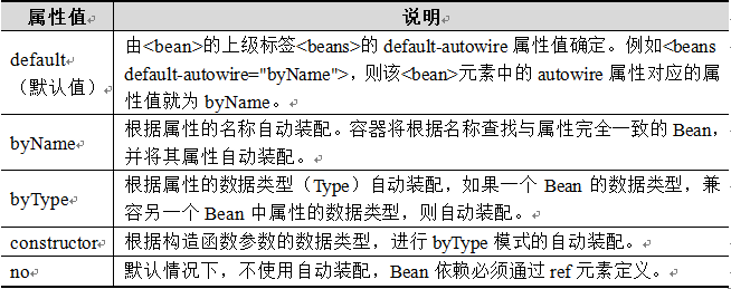
XML文件:
<?xml version="1.0" encoding="UTF-8"?>
<beans xmlns="http://www.springframework.org/schema/beans"
xmlns:xsi="http://www.w3.org/2001/XMLSchema-instance"
xmlns:context="http://www.springframework.org/schema/context"
xsi:schemaLocation="http://www.springframework.org/schema/beans
http://www.springframework.org/schema/beans/spring-beans-4.3.xsd
http://www.springframework.org/schema/context
http://www.springframework.org/schema/context/spring-context-4.3.xsd">
<!-- 使用bean元素的autowire属性完成自动装配 -->
<bean id="userDao" class="com.itheima.annotation.UserDaoImpl" />
<bean id="userService"
class="com.itheima.annotation.UserServiceImpl" autowire="byName" />
<bean id="userController"
class="com.itheima.annotation.UserController" autowire="byName"/>
</beans>
用于配置userService和userController的<bean>元素中除了id和class属性外,还增加了autowire属性,并将其属性值设置为byName。在默认情况下,配置文件中要通过ref来装配Bean,但设置了autowire=“byName”后,Spring会自动寻找userService Bean中的属性,并将其属性名称与配置文件中定义的Bean做匹配。由于UserServiceImpl中定义了userDao属性及其setter方法,这与配置文件中的id为userDao的Bean相匹配,所以Spring会自动地将id为userDao的Bean装配到id为userService的Bean中。自动装配同样能完成依赖注入。
第2章 Spring中的Bean的更多相关文章
- spring(四):spring中给bean的属性赋值
spring中给bean的属性赋值 xml文件properties标签设置 <bean id="student" class="com.enjoy.study.ca ...
- JSP访问Spring中的bean
JSP访问Spring中的bean <%@page import="com.sai.comment.po.TSdComment"%> <%@page import ...
- 传统javabean与spring中的bean的区别
javabean已经没人用了 springbean可以说是javabean的发展, 但已经完全不是一回事儿了 用处不同:传统javabean更多地作为值传递参数,而spring中的bean用处几乎无处 ...
- 1.2(Spring学习笔记)Spring中的Bean
一.<Bean>的属性及子元素 在1.1中我们对<Bean>有了初步的认识,了解了一些基本用法. 现在我们进一步理解<Bean>属性及子元素. 我们先来看下< ...
- spring扩展点之二:spring中关于bean初始化、销毁等使用汇总,ApplicationContextAware将ApplicationContext注入
<spring扩展点之二:spring中关于bean初始化.销毁等使用汇总,ApplicationContextAware将ApplicationContext注入> <spring ...
- spring 中的 bean 是线程安全的吗?
spring 中的 bean 是线程安全的吗? Spring 不保证 bean 的线程安全. 默认 spring 容器中的 bean 是单例的.当单例中存在竞态条件,即有线程安全问题.如下面的例子 计 ...
- Spring 中的bean 是线程安全的吗?
结论: 不是线程安全的 Spring容器中的Bean是否线程安全,容器本身并没有提供Bean的线程安全策略,因此可以说Spring容器中的Bean本身不具备线程安全的特性,但是具体还是要结合具体sco ...
- Spring中与bean有关的生命周期
前言 记得以前的时候,每次提起Spring中的bean相关的生命周期时,内心都无比的恐惧,因为好像有很多,自己又理不清楚,然后看网上的帖子,好像都是那么一套,什么beanFactory啊,aware接 ...
- 【Spring】Spring中的Bean - 5、Bean的装配方式(XML、注解(Annotation)、自动装配)
Bean的装配方式 简单记录-Java EE企业级应用开发教程(Spring+Spring MVC+MyBatis)-Spring中的Bean 文章目录 Bean的装配方式 基于XML的装配 基于注解 ...
随机推荐
- 028 ElasticSearch----全文检索技术03---基础知识详解01-IK分词器和映射
1.IK分词器 (1)安装 使用IK分词器可以实现对中文分词的效果.下载IK分词器:(Github地址:https://github.com/medcl/elasticsearch-analysis- ...
- es+logstash+kibana搭建
1.简介 ELK(elasticsearch+logstash+kibana)是目前比较常用的日志分析系统,包括日志收集(logstash),日志存储搜索(elasticsearch),展示查询(ki ...
- 『2019Summer Algorithms』
一个暑假两次集训,感觉学了好多好多的东西,也挖了好多好多的坑,于是就决定写一篇关于算法的总结,用于熟悉新算法,也留下一点对新算法的理解. AC自动机 简单的说就是在\(trie\)树上实现\(KMP\ ...
- Java之利用Freemarker模板引擎实现代码生成器,提高效率
https://blog.csdn.net/huangwenyi1010/article/details/71249258 java模板引擎freemarker代码生成器 更多 个人分类: 一步一步 ...
- C#使用HttpWebRequest发送数据和使用HttpWebResponse接收数据的一个简单示例
新建一个.NET Core控制台项目,代码如下所示: using System; using System.Text; using System.Net; using System.Collectio ...
- 使用HttpWebRequest和HttpWebResponse时接收数据中文乱码的情况
今天在调试一个get请求的接口的时候发现HttpWebResponse方法接收数据的时候,中文出现乱码的情况. 原因是格式编码转码的问题. 原来自从Windows 2000之后的操作系统在文件处理时默 ...
- 理解 Kubernetes 的亲和性调度
这次给大家介绍下k8s的亲和性调度:nodeSelector.nodeAffinity.podAffinity.Taints以及Tolerations用法. 一般情况下我们部署的 POD 是通过集群自 ...
- Git 解决合并分支时的冲突
参考链接:https://www.liaoxuefeng.com/wiki/896043488029600/900004111093344 创建分支时,新分支的文件内容建立在原分支的基础上,我们称这时 ...
- django中navie时间和aware时间详解
navie时间和aware时间: 什么是navie时间?什么是aware时间? navie时间:不知道自己的时间表示的是哪个时区的.也就是不知道自己几斤几两.比较幼稚. aware时间:知道自己的时间 ...
- v2 配置
记录一下怕自己忘记了 v2配置 v2加速 cdn加速 hostwind 服务器 namesilo 域名网站
